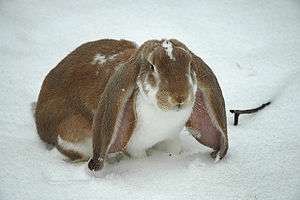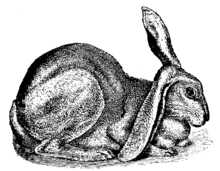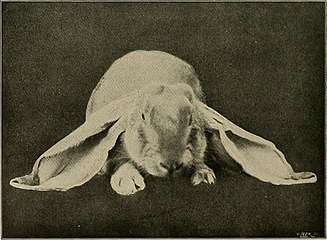Lop rabbit
Lop rabbit or lop-eared rabbit refers to any rabbit with ears that droop, as opposed to being carried erect. A number of rabbit breeds (listed below) are characterized by such lop ears. Abnormalities in the skull of a half-lop rabbit were studied by Charles Darwin in 1868.

Ear carriage

The defining feature of the lop rabbit is its ear carriage. Unlike the erect ear of the majority of domestic rabbit breeds, lop breeds have ears loosely drooping, with the opening of the ear facing the skull. Due to the slightly-raised cartilaginous ear base, the head of many lop rabbits (with the exception of English Lops) has a small bulge, referred to as the crown. The head of a typical lop rabbit is said to resemble that of a male sheep in profile, thus the German term for a lop rabbit (Widder, meaning Aries [the ram]), the French term (bélier, meaning ram) and the Italian term (ariete, from Latin aries).
A rabbit's ear, with its blood vessels close to the surface, is an essential thermoregulator,[1] since rabbits cannot sweat. Longer ears are associated with warmer climates, and possibly even with a late-spring birth in cooler climates (when such rabbits are thought to develop summer ears).[2] The additional weight of a longer or thicker ear is not always fully supported by the rest of the ear structure, resulting in ears that droop. The ears of some young lop rabbits may not achieve their full adult droop until the ear growth is finished.
Ear type
Rabbits are known to carry their ears in one of five ways:[3]
- Erect ears (the most common): Both ears are carried upright. Such ears may at times rest atop the rabbit's back, or be temporarily smoothed down by the rabbit when it bathes or grooms itself.
- Full lop ears (less common): Both ears hang fully down, brushing the rabbit's cheeks and shoulders. Such ears may gently undulate as the rabbit hops.
- Half lop ears (uncommon): One ear is carried in a full (or nearly-full) droop, while the other ear is carried erect. Similar in appearance, a now-extinct one-eared rabbit—said to resemble a unicorn—was breeding true around the end of the 18th century, and in 1958 two such healthy specimens were photographed.[3]
- Oar lop ears (uncommon): Both ears are carried roughly horizontal to the ground and out over the rabbit's shoulders. The term comes from the resemblance to a boat's oars at rest. In modern times, these are sometimes referred to as helicopter ears.[4]
- Horn lop ears (rare): Both ears are carried roughly horizontal to the ground and out over the rabbit's nose. The term comes from the resemblance to the forward-facing horns of some cows.
 Erect ears.
Erect ears.
Illustration by [E. Whimper?], ca. 1862 Full lop ears
Full lop ears
Unknown artist, 1875 Half lop ears
Half lop ears
Illustration by E. Whimper, ca. 1862 Oar lop ears
Oar lop ears
Illustration by E. Whimper, ca. 1862 Horn lop ears
Horn lop ears
Illustration by E. Whimper, ca.1862
Ear length

Longer (or thicker) ears are more likely to droop. Some lop-eared rabbits have been deliberately bred for exaggerated ear length.[5] As this can be considered detrimental to the rabbit's health, requirements in Germany "ban rabbits with ears over 25.5 inches (65 cm), and in Holland, 27.5 inches (70 cm) is as long as they can be allowed [in shows] before disqualification."[3] The Guinness World Records award for "Longest ears on a rabbit" was given in 2003 to an English Lop in the United States with ears measuring 31.125 inches (79.06 cm).[6]
Breeds of lop-eared rabbit
Though the majority of rabbit breeds have erect ears, lop-eared breeds make up approximately 15% of all the breeds currently recognized by the American Rabbit Breeders Association (ARBA)[7] or the British Rabbit Council (BRC).[8] Such lop-eared breeds include:
- American Fuzzy Lop
- Cashmere Lop
- Canadian Plush Lop
- Dwarf Lop
- English Lop
- French Lop
- German Lop
- Holland Lop [US]
- Meissner Lop
- Mini Lion Lop
- Mini Lop [US]
- Miniature Cashmere Lop
- Miniature Lop [UK/NL]
- Plush Lop (Standard) not yet recognized; in development
- Plush Lop (Mini) not yet recognized; in development
- Teddywidder
- Velveteen Lop
See also
References
- Fayez, I.; Marai, M.; Alnaimy, A.; Habeeb, M. (1994). Baselga, M.; Marai, I.F.M. (eds.). "Thermoregulation in Rabbits" (PDF). Rabbit Production in Hot Climates. Cahiers Options Méditerranéennes. Zaragoza: CIHEAM - International Centre for Advanced Mediterranean Agronomic Studies. 8: 33–41.
- "Summer Ears?". Dutch by Briony. Retrieved 12 February 2018.
- Whitman, Bob D. (October 2004). Domestic Rabbits & Their Histories: Breeds of the World. Leawood, KS: Leathers Publishing. ISBN 978-1585972753.
- Wolf (5 June 2016). "Rabbit communication: watch those ears!". Small Pet Select. Retrieved 12 February 2018.
- Roth, William F.; Cornman, Charles T. (1914). Rabbit Culture and Standard: A Complete and Official Standard of All the Rabbits. Poultry Item Press. Retrieved 9 February 2018.
- "Longest ears on a rabbit". Guinness World Records. Retrieved 9 February 2018.
- "ARBA Recognized Breeds". American Rabbit Breeders Association. Retrieved 9 February 2018.
- "Breed Standards 2016-2020" (PDF). The British Rabbit Council. Archived from the original (PDF) on 21 January 2018. Retrieved 9 February 2018.|